Picture the outline of the state of Louisiana, and the image in your mind is wrong. Louisiana is losing ground. As Elizabeth Miller found, the only thing permanent about the Louisiana coastline is constant change. As the ground under their feet succumbs to the tides, local residents are forced make impossible choices.

We took the boat out farther than it was built to go. The field notes later tersely reported, “Should have come inside earlier. Significant chop.” On the spine-compressing ride back toward the dock, the boat galloped from one swell to the next in the kind of open water it wasn’t really meant to ride. I kept my seat by holding onto it with both hands while seawater splashed over the sides. The trolling motor smashed against the bow and broke.
We’d launched onto a quiet bayou an hour’s drive south of New Orleans, then cruised through calm waterways, raising binoculars after heron and egrets. We were aiming for a manmade island that marks what used to be Louisiana’s southern edge and looking for evidence of the efforts to reconstruct a vanishing coastline along the way. At one point on our south-bound trip, Healthy Gulf community science director Scott Eustis showed me his GPS. The screen indicated we should be in a channel. Instead, open water surrounded us.
Every map you look at of Louisiana is a lie. They simply can’t keep up. A relatively current print edition will show a chunk missing from between the highways that run alongside the farmland, fishing docks, and oil and gas processing stations to the southern fringes of the state. In satellite images of the coast, pond names hover over expanses of blue. The broad fans of the Mississippi River’s delta have washed away into thin strips. That river poured the landscape into place over millennia, but it’s taken just a century to unravel it.
I live in the Southwest, where climate change seems to creep closer while your gaze is elsewhere. You turn back and think, doesn’t that seem closer than it was the last time I looked? We perceive absences — less rain, fewer cold days — belatedly. When it shifted is tough to say; we won’t know the last hard winter until it’s long gone. So when an ecologist from the Gulf Coast offered to show me places where you could see the changes unfolding now, I set a date to head southeast. I came, as well, to draw my own map of a place before that place is erased.
My boat trip south with Eustis meandered through placid bayous to widening bays, along the bleached skeletons of ghost forests. Rising saltwater has poisoned hardwoods and sea pines, leaving empty twigs reaching for the sky. Drowning grasses swayed in saltwater. We slowed down where houses bracket the waterway like it’s main street through downtown. People waved from some front porches. On others, rooftops have chipped away, opening their contents to the weather. Too-long-docked boats have buckled.
Every map you look at of Louisiana is a lie. They simply can’t keep up.
Louisiana’s is a working coast, and we caught it at work. We passed through corridors lined with poles that signal oyster beds and the metal pipes and platforms for oil wells. Oystermen returning from fishing overnight sped the opposite direction while shrimping boats, their season just starting, waited with their nets up like raised wings. The long-term forecasts suggest that none of this will last. Not the ground, not the houses, not the way of shuttling out here in small boats to oyster beds laid into place on top of generations of other oysters’ shells, or, as we watched one fisherman do, standing on a dock, throwing a small net into the tide, and pulling it back writhing with sea life.
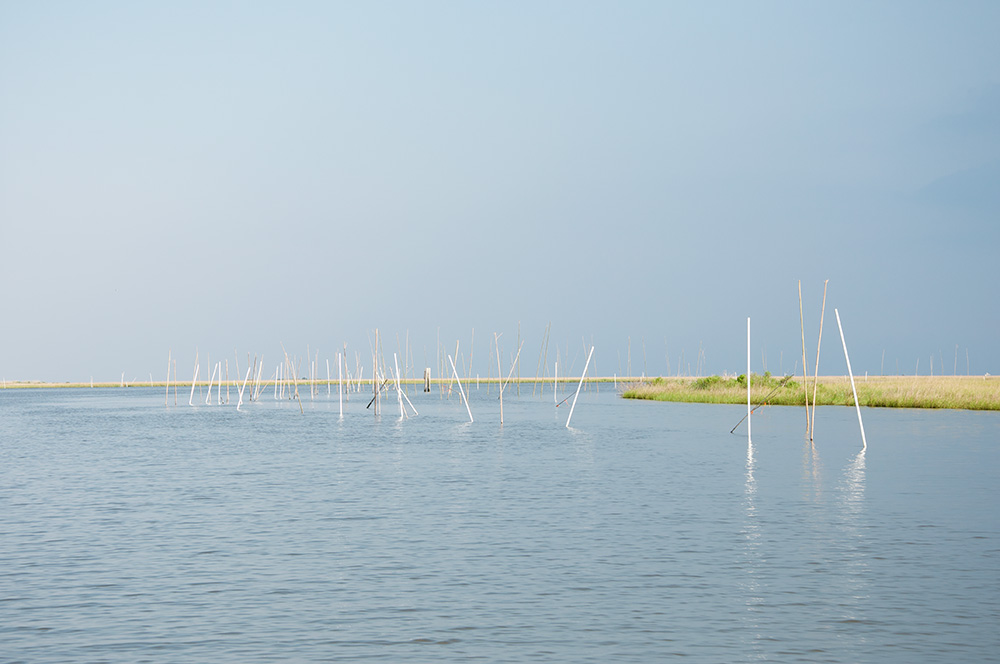
When Eustis suggested finishing a tour of the bayous by seeing a rebuilt barrier island, it meant venturing far beyond the mellow backwaters that our boat captain, Chad, frequents with customers fishing for speckled trout and redfish. We looked at a sky piling up with dark blue and purple storm clouds and decided to make a run for it. Almost as soon as we set off, lightning cracked the horizon. We picked up speed, and so did the waves. Repeatedly, Chad shouted over the wind and engine noise, “How far to the island?”
Eustis checked his GPS and urged him onward until we reached the place where dredged and heaped sand from the Gulf of Mexico brought the surface of the island back above the water. Now, it’s an emerald band, its gray beach promptly swallowed by dense, tall grasses and then the thick foliage of trees.
“Even if the island goes underwater, it’s still protection, because it’s 10, not 15 feet of water in the storm surge,” Eustis said. “In 2012, it was worth it. In 2022…?”
We watched a line of pelicans undulating on the wind and dolphins shadowing a shrimp boat, leaping in arcs through its wake. Then, Chad declared it time to turn back.
Eustis stood at the wheel beside Chad, steady as we hurried to the dock. A Louisiana native in his mid-30s, with a boyish face and short hair he anxiously combs with his fingers, Eustis was in a graduate program in Georgia when Hurricane Katrina hit in 2005. He came home to help rebuild his family’s house, which is now done, and the rest of the coast, work that may outlast his lifetime.
Humans are rebuilding islands and marshes to thwart, or at least stall, their loss to rising seas, sinking soils, and worsening storms. But Louisiana’s $50 billion plan, their latest figure as of 2017, won’t buy back as much land as has been lost or preserve every coastal community. Some measures could displace people, and some deliberately relocate them. Others may deplete fisheries. Many of the communities the state says it can’t afford to save are rural, poor, and African American or Native American communities on Louisiana’s coastal plain. They are scrambling on a shifting landscape, determining whether to adapt or move. This place is changing faster than people can forget what it was like before. What I’ll see here are the impossible choices that change demands, and the many sacrifices layered in so much compromise.
In his work with Healthy Gulf, Eustis both champions restoration efforts and watchdogs how they balance or provide for the matrix of people, habitats, and wildlife affected. The state has said it’ll monitor how river diversion projects affect marine life, including oyster beds and shrimp fisheries and the people who make their living from them, as well as wildlife like dolphins, who could be pushed out if, as the state plans, a diversion reroutes fresh water into these brackish channels.
“I don’t think they want to forgo an approach to building land just because there are some sick dolphins or some oyster beds,” Eustis said. “If that’s the decision you’re going to make, then you need to compensate people. And I don’t know how you compensate dolphins.”
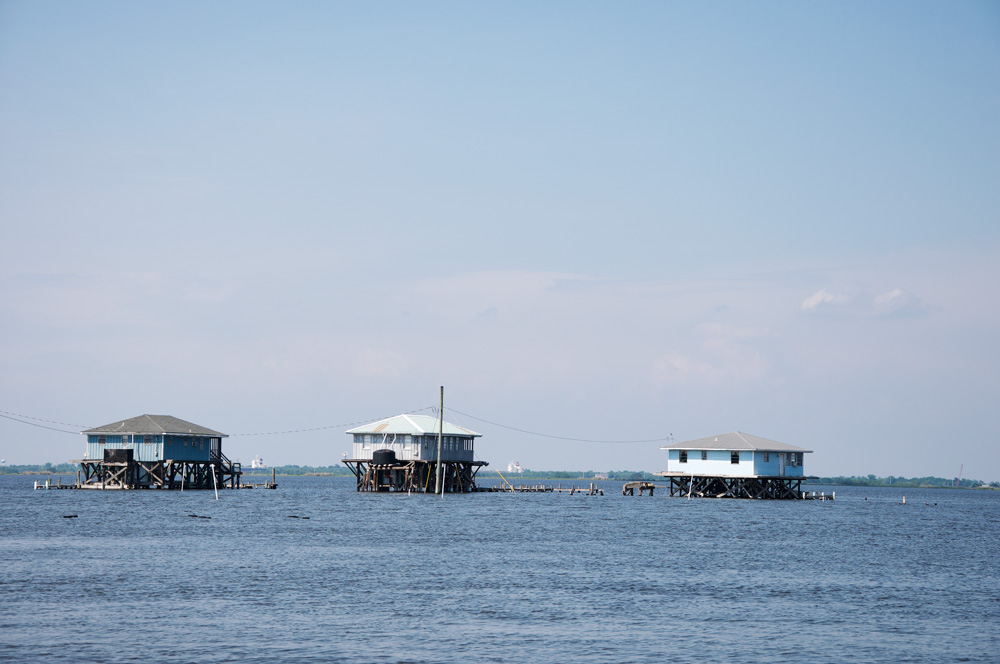
Despite one of the largest efforts to reshape their own landmass underway in the world, research suggests that efforts to rebuild these wetlands can’t keep pace with the speed at which they’re lost. Still, if they do nothing, the sea will swallow all the barrier islands now lining the Gulf of Mexico and the most determined stands of grass, blurring it all into one large body of water. In the next half-century, another 2,250 square miles land is likely to disappear. Today’s maps won’t just look a little off. They’ll look like the product of myths.

At the LSU Center for River Studies in Baton Rouge, a group of 70- and 80-year-olds peered down from the second-floor balcony onto a scale model of 14,000 square miles of river delta. It’s the size of two basketball courts. While images of reedy wetlands and maps of future scenarios projected across the model’s white, molded foam surface, a man seated on a collapsible stool, his elbows propped against his cane, asked Chuck Perrodin, the Coastal Protection and Restoration Authority public information director, “What’s happening in Atchafalaya Basin? Is that covered?”
“No,” Perrodin replied, “there’s only so much money in the world, and we’re glad we got the money to do this.”
The man remembered when gates were installed across the Atchafalaya River and the color of its water changed. This landscape has shifted within human memories — their memories. They recall a very different bayou from their youth.
Almost 2,000 square miles of wetlands have disappeared from Louisiana over the last century.
The Center for River Studies, part of a growing cluster of buildings for the partnered operations of Louisiana’s Coastal Protection and Restoration Authority and Louisiana State University, is part museum, part laboratory, and part campaign effort. Its centerpiece is the model, which uses running water and black plastic pellets that mimic sediment to allow researchers to test cumulative and lasting effects of the state coastal restoration efforts. In an hour, they can mirror a year’s worth of change. The computers that run it sit beside stairs that ascend to its surface and a cluster of white sandals used for walking atop it. I caught it at the semester’s end, after water had been flushed over the surface to reset it. Some still pooled over the grid marking New Orleans.
As the senior group headed back toward their bus, Perrodin guided me back to the museum-like portion of the center, with its floor-to-ceiling map of tributaries as far away as the Canadian border and an airboat and fronds of plastic grass stationed in front of a painted screen of wetlands. In a small auditorium, he sped through the presentation they give to visitors, explaining how the delta was built, how the levees have deprived it, how the state has a plan to save the place and its people, and what’s at stake for the rest of the country if they don’t.
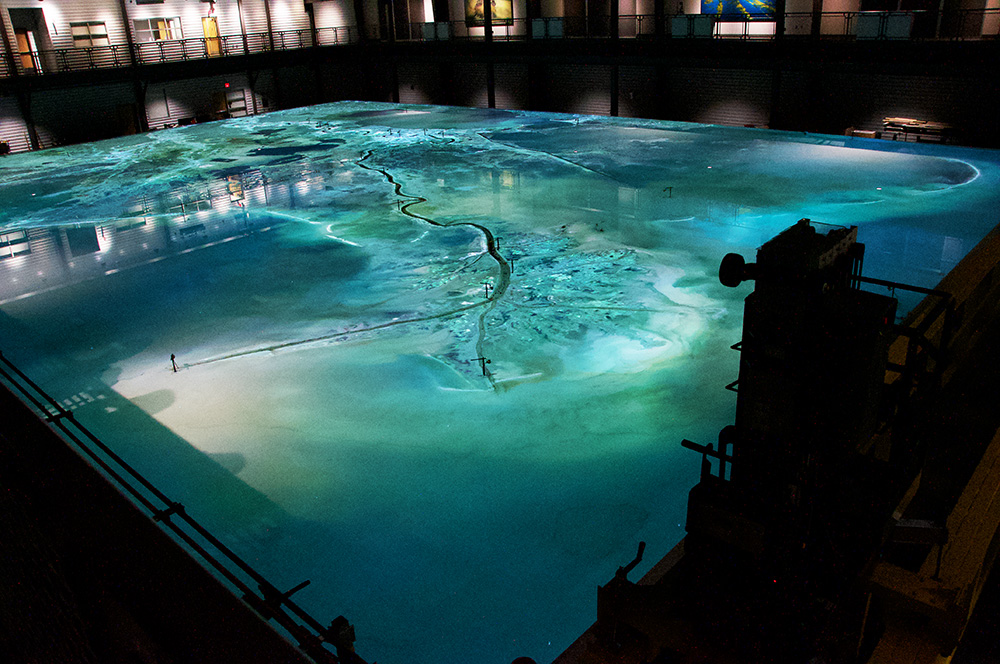
As ice sheets melted and mountains eroded from tributaries covering almost half the United States, the Mississippi River poured that sand, silt, and clay into the Gulf of Mexico. Over 7,000 years, the river drew its delta out into the sea. Routinely flooded wetlands built up like a layer cake of mud. The river’s webbed course so confounded early explorers that it took three centuries to determine where, exactly, it ended. That was the beginning of its end. The 1900s saw the river dredged to make a shipping channel, dammed, and leveed after a flood covered 26,000 square miles and killed two hundred people in 1927. Scientists warned that the levees would devastate the ecosystem. The Army Corps of Engineers built them anyway.
Wetlands naturally compress over time, but that’s accelerated now by oil extraction, which left subterranean gaps that soil sinks down to fill and was facilitated by thousands of miles of canals dug to access those wells, each working like an invitation for water, as well as rising ocean levels. Add to that increasingly frequent and severe storms. The results: Almost 2,000 square miles of wetlands have disappeared from Louisiana over the last century, according to the U.S. Geological Survey, a loss unprecedented in the last thousand years.
Water swallows the land from the roots up. The trees die first. Then, they’re followed by the dense thickets where birds hide. Grasses survive for a while, essentially up to their necks in water, before they, too, die. When their grip on the earth releases, the sea has easy work eroding the soil.
The delta’s destruction will make it harder for Americans to gas up their cars, buy bread, and find oysters on the half-shell or a shrimp cocktail. The delta supports 30 percent of the United States’ commercial fishing catch, protects five shipping ports that move 500 million tons of cargo each year including 60 percent of the nation’s grain, and sees roughly 20 percent of the nation’s oil and gas transported through it. The state estimates the value of the ecological systems in the Mississippi Delta at somewhere between $237 billion and $4.7 trillion. There is, in other words, an economic case to be made for saving these areas. Which is good, because it also comes with an enormous price tag.
The Louisiana Coastal Protection and Restoration Authority’s plan to preserve wetlands and barrier islands calls for some of the most expensive and large-scale ecological restoration projects in the country. They’re building barrier islands, stabilizing banks, dredging or piping sediment in to create marshes, constructing levees, heaping barrier reefs of oyster shells, and pouring muddy freshwater into increasingly saline bays. The plan’s 2017 draft listed 120 projects affecting more than 800 square miles, including $18 billion in marsh creation and $5 billion in sediment diversions. Much of the money will come from oil and gas industry royalties, compelling state leaders to push for more fossil fuel extraction even as burning that fuel warms the atmosphere, melts the ice caps, and brings the ocean a little closer to their front doors.
It’s also a plan that leaves some people out. The dock Eustis and I sped back to in Jean Lafitte and everything south of it are outside the lines of any levee, left to be overtaken by water surging inland with the next hurricane. There’s “angst,” Perrodin said, “about not having the resources to save everybody and everything. … How do you tell Jean Lafitte, ‘Sorry, can’t do it’?”
But they can’t. Even what they’ve already done won’t last. Piped in or poured sediment can rebuild wetlands. Seedlings take root and, for a while, the ground is firm enough to walk on. But the soil immediately begins compacting. Plants sink, then drown. And these projects work on a smaller scale, a pocket-sized solution to an ocean-sized problem.
“We’ve done hundreds of thousands of acres,” Perrodin said. “But we don’t need thousands of acres. We need thousands of square miles.”
So the state has proposed to slice the levee walls open. Up to 50,000 cubic feet per second of the muddy Mississippi would rush into blue-green saline water, streaking it beige. The remnants of Appalachian Mountains, Iowan farms, and Nebraskan prairie dust would settle atop the twiggy muck of decaying vegetation. Layers of new soil would smooth over the mass of rot. If you were to take a soil core years later, the line between the two could be visible to the naked eye. Eventually, it would make marshes appear in open water.
“What we’re trying to do here, in a controlled way, is mimic what the river used to naturally do,” Perrodin said. “It’s not going to make a visible difference in what’s left of my lifetime, but in the long run, the sediment diversion will build more sustainably. … Some people want us to keep piping and dredging, and not diverting. We have to do it all.”
For best effectiveness, those solutions should have been deployed decades ago. Perrodin has a well-trodden metaphor for this work: the best time to plant a tree is thirty years ago, but the second-best time is now.
Success is not assured. Recent research out of Tulane University found diversions rebuild land slower than these wetlands are disappearing. The study’s own sites will likely soon be submerged.
“Even with the best restoration strategies, it’s not possible to build land at the rates we’ve been losing it,” said study co-author Elizabeth Chamberlain. “The language ‘restore the coast’ gets used, and the reality of what we’re finding is that it’s pretty unlikely that the coast can be restored to what it looked like one hundred years ago, before we lost all this land. Really, our best hope is to build something sustainable or a sustainable delta, which will be different than what we’re looking at right now or what people remember when they were kids.”
Perrodin scrolled through maps of projections for Louisiana’s coastline in 2050. In the worst-case scenario, the one in which they do nothing, the only land that remains is what asphalt highways hold in place.
“The future without action,” he said, “is, everything goes away.”

After Hurricane Katrina, a forest of cranes clustered to construct miles of levees, flood walls, gates, and pumps to defend New Orleans. Projects consumed more than $20 billion in federal, state, and local government aid. Some surge barriers are 26 feet high and almost two miles long, but even that may not be enough to save the city. Those levees work best with a buffer of wetlands, but it was their construction, not wetlands restoration, that was expedited. The levees may worsen conditions for the communities outside their walls if they block tidal surges that accompany storms and that water stalls out amid these towns. In some places, the coastal restoration plan largely comes down to making sure highways stay clear so people can drive away from their flooding homes.
I drove those highways south, heading out of the city of New Orleans for as far as they go. I passed over or through earthen berms and cement walls and between steel flood gates. A well-groomed four lanes led into Plaquemines Parish, passing citrus orchards, cattle pastures, and yards full of crab traps, as well as pipelines, storage tanks, and oil and gas processing and shipping infrastructure. When I reached the sign marking the southernmost point of the state, I was hours south of protective measures other than good pavement.
Oystercatchers strolled through roadside puddles. Where the pavement stopped, water pooled over the highway.
About twenty miles from that southern terminus, a sign pointed toward the Grand Bayou Village Road, a Native American village — primarily Atakapa-Ishak/Chawasha — that I’d seen by boat with Eustis. The shell-gravel road started with a steep climb over a levee. The air smelled brackish. The road led to a dock because the place is still, as it has always been, accessed only by water. As we passed through Grand Bayou Indian Village’s rows of houses, Eustis told me, “This is one of the places where they look, like Buras, at hurricanes in 2067, and say, ‘Maybe we can’t keep people here.’ [But] like a lot of places in Plaquemines Parish, people want to stay as long as they can.”
Pickup trucks and boat trailers were parked among heaps of oyster shells by a dock lined with several motorboats topped with shade awnings and shrimp boats with their gray and green nets carefully draped away. An abandoned boat slumped against the wooden platform. It was left so quickly that curtains still fluttered against shattered windows and fishing gear rusted in a jumble covering its decks.
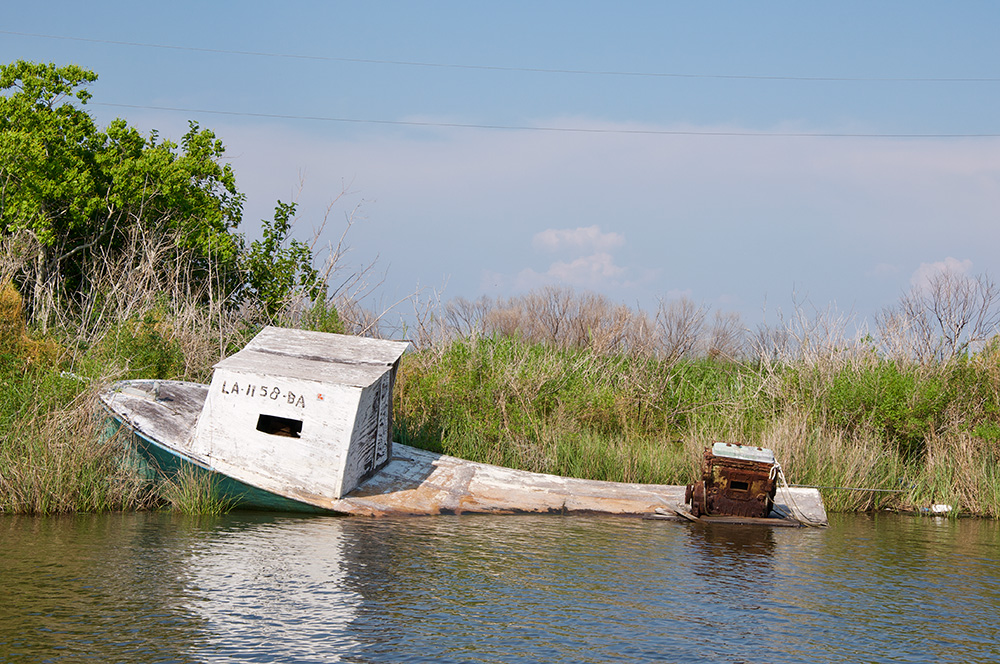
As colonists moved into Louisiana in the 1700s, they fixed some once semi-migratory Native American tribes into these coastal areas. Most of the members of the Houma Nation, the largest tribe in Louisiana, live between the Atchafalaya and Mississippi Rivers, a homeland that overlaps with some of the fastest land loss in the world.
Some have decided the only solution is to move. Already, the Biloxi-Chitimacha-Choctaw community Isle de Jean Charles has begun the process of moving from an island that was once 24 square-miles and is now just half a mile long and a quarter mile wide. High tide regularly reaches front yards and swamps their road, and saltwater has wiped out their fruit trees and farms. The federal government is spending millions to relocate these first climate change refugees to a former sugarcane farm. Monique Verdin, a Houma Nation member, documentary filmmaker, and activist pointed out that the move plants them among two impaired water bodies and oil and gas facilities.
“Is that really better?” she asks. “Are we upping our quality of life here? Or should we remain and develop a way to adapt?”
Verdin lives on land her grandparents settled when that scrap of marsh at the southeastern tip of Louisiana was all Native Americans were allowed to own. Her house is ringed by cypress, bottomland hardwood forest, and two major oil refineries. Fifteen minutes down the road, the woods give way to fishing docks. After Hurricane Katrina submerged the area, three-quarters of its population moved away. Some residents have returned, but not as many as there were.
“Especially after Katrina, people are like, ‘Oh, people shouldn’t live here,’” Verdin told me. “Actually, our people have lived here for a really long time. You just have to know how to and respect the water in a way we have not respected it for a really long time, especially the Mississippi River.”
On my drive south, I stopped for the night in Buras, taking a room in a hotel where I was the only occupant. My room looked over a swimming pool hosting a flotilla of leaves. The receptionist summarized the town: “At one time, there was a Dairy Queen and a bowling alley, but guess what? It wasn’t long before they both closed. … Ain’t nothing down here. Nothing for kids to do. But I’ve been here my whole life and I guess I’m all right.”
It was true, there was little to do. A few roadside stands served food — I searched for dinner options and landed only a take-out shrimp po’boy. One gas station advertised itself, with its bowl of bananas beside the cash register as a “grocery store.” In the morning, I bought coffee, a banana, and a pre-package muffin there and continued driving. So much land has eroded that the road was lined with parked vehicles and people fishing out of their trunks. Oystercatchers strolled through roadside puddles. Where the pavement stopped, water pooled over the highway.

The Breton and Chandeleur islands curve against the ocean like a drawn bow. The two form part of the nation’s second oldest wildlife refuge, designated by President Theodore Roosevelt to protect the pelicans that live and nest there. In addition to critical habitat, these barrier islands and others like them offer the first line of defense against storms for the mainland. But, like coastal wetlands, they’re also disappearing. When Louisiana started its restoration effort, it began by pouring islands back into place, like the one I visited with Eustis. Those islands drew back onto the map the line for where the state used to reach, marking the space restoration efforts aimed to reclaim from the sea.
But barrier islands are not made to last. The hydrology that builds them also breaks them down. They migrate on prevailing currents west toward Texas from where they emerge near Florida. Storms wear them down, shuffle their sediment through the system, and then settle it elsewhere. Islands have always vanished. But they used to reappear. Dams and levees on the Mississippi River that deprived wetlands of sediment similarly starved these islands. Now islands disappear, sometimes in a single storm, and never re-emerge.
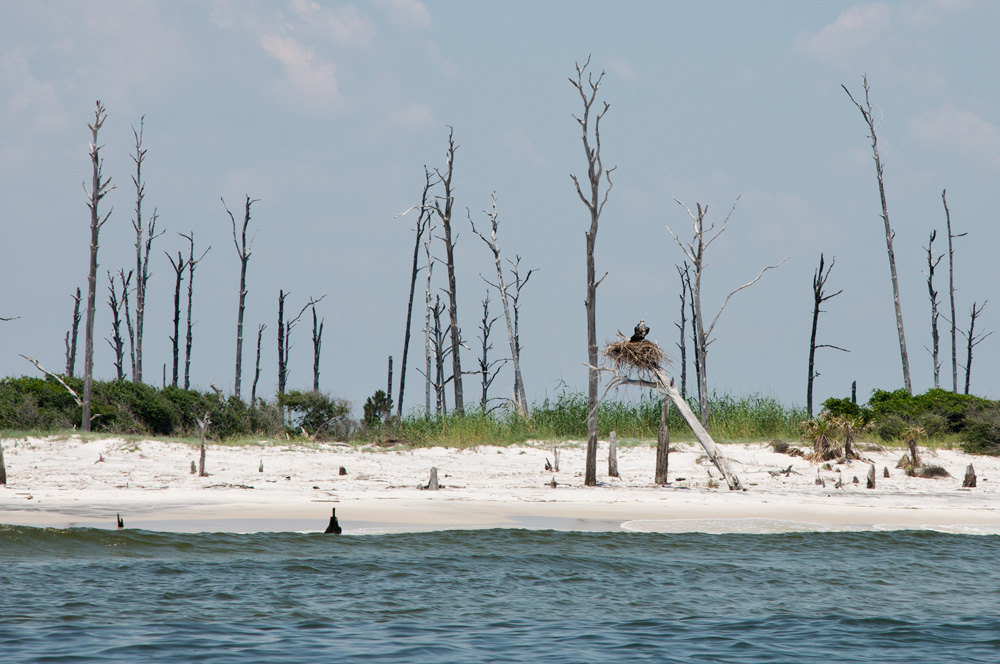
Researchers found Breton and Chandeleur are losing land faster than any other islands in the Gulf of Mexico. Adding sand to the islands’ flanks would build marshes, dunes, and sandy shorelines where birds and sea turtles can lay their eggs, the researchers concluded, but only for a while. They could not be saved. In the next two decades, Breton Island is expected to become a recurrent sandbar, useless to the nesting seabirds it was supposed to help save.
I had hoped to see it, but at a full two hours by boat from the coast, even refuge staff rarely visit. So I drove into Mississippi instead, where the closest islands of the 160-mile-long Gulf Islands National Seashore are visible from the beach. It was my best chance to see hints at what’s happening far offshore, and another ecologist with a boat had offered to show me. His recurrent contracts with federal agencies prompted him to ask me not to use his name. It’s a tough time for a government hire who wants to talk about climate change.
He steered the boat past an island where a curl of smoke wafted off a wildfire and a state-funded project had dumped tons of sand in hopes of shielding casinos onshore from future storms. Those casinos were just pastel blips on a murky horizon when we reached West Ship Island, ten miles off the coast. Beachgoers unloaded from a ferry and traipsed by an old military fort. The fort was built at the island’s edge during the Civil War, but the island has shifted around it, and the fort now sits near its center. Waves had reached its red brick walls by 2010. The National Park Service, which manages the national seashore, doesn’t intervene in natural processes, even when it means watching islands they’re overseeing deteriorate. But this wasn’t an altogether natural process. Dredging a nearby shipping channel was accelerating erosion, park service staff decided, so they stepped in. Sand was added to the beach to push back the water, and now, it seeps in some of the ground-level windows. Stepping onto the dunes to peer in at a sun-filled interior courtyard, I came immediately under assault of sand fleas stinging their way up my ankles. I scrambled back onto the boardwalks that traverse the island.
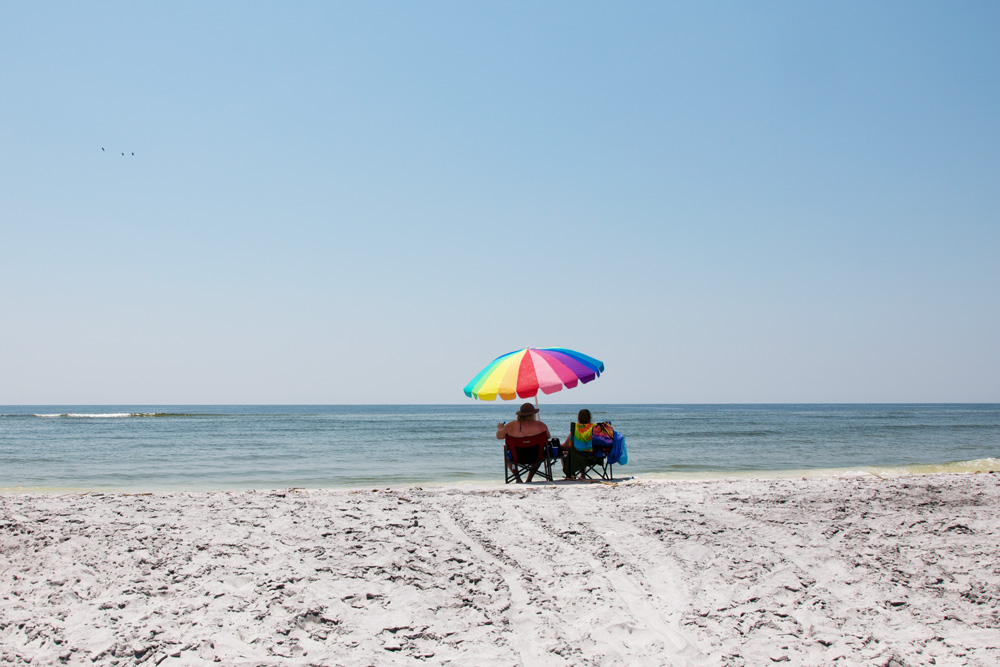
Their path passes ponds where red-winged blackbirds called from cattails and rattlebox bushes offered seed pods for shaking. On the island’s Gulf-facing side, umbrellas and chairs lined the beach just past the changing rooms and snack bar. The buildings’ lower walls have been so routinely flooded that they’re now built with plastic siding instead of drywall. Those boardwalks have been torn up by storms and reconstructed so many times that this iteration has been nailed together instead of screwed. In the next storm, water and wind can lift the planks out of place and leave the struts in place, reducing the costs to rebuild. This is yet another place people are trying to learn how best to adapt, how to rebuild, and what to let go.
At one time, trees shaded these islands. They housed indigenous villages, then small military outposts. As these islands erode, layers of those historic inhabitants surface: belt buckles and buttons from early colonists, and arrow points and even human remains from those who lived and died here centuries ago.
If National Oceanic and Atmospheric Administration forecasts of three feet of sea level rise over the next half century bear out, that will swallow half of the islands in the Gulf Islands National Seashore. By some forecasts, sea levels could rise as much as six feet. At that point, almost nothing would remain. There’s every reason to expect that we will outlive this geography.
“There’s a lot of pieces in motion — rising sea levels, storms, human impact — like cogs in a breaking machine,” my guide told me. He takes his teenage sons to these islands as much as he can, certain that they won’t still exist by the time his boys are his age.
“This is not a unique story. Anywhere in the world we have barrier islands, this is occurring,” he said. “It’s all going to change. We just don’t know how.”
He’d said he’d show me climate change in action, and he did, pointing out edges broken by erosion, ghost forests, and places water had already claimed. As we visited other islands, these without docks, I jumped off the boat into warm, thigh-deep shallows. My sunscreen washed off and my calves burned as we walked one island’s edges after another. These sandy beaches provide habitat for endangered sea turtle nests, and a trail of clawed footprints on either side of the line of a dragged tail suggested one was also home to an alligator. Osprey and eagle nests added knotted tops to spindly, dead trees.
With a peak elevation of about four feet, in an area where an afternoon thunderstorm’s worth of wind can override the tide and carry water inland, these islands are living on borrowed time. In one such washover, standing saltwater had broiled in the sun so long that it was almost too hot to walk through. The water marked a weak point where a storm could rip the island in two. I wanted a map not to see where we are going, but to show where we have been. I wanted a map as a record of everything we used to have.
At certain corners of barrier islands, where the current curls around one edge and merges with those washing off the opposite face, the waves seem to stand still. They’re just a subtle gesture moving over the earth and catching the light. Standing shin-deep in that water, all that moves is the sand sinking away underfoot.
This work was supported in part by the Banff Center for Arts and Creativity’s environmental reportage program.
If you enjoyed The Losing Coast, you’ll find more great reads on American places and cultures in our collection of Statesider original stories.
